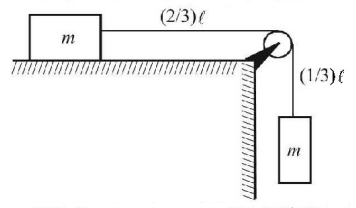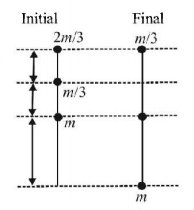Question
Two objects each of mass $$m$$ are connected with a uniform rope having same mass $$m$$ and length $$\ell = \frac{{10}}{3}m$$ are shown in the figure. The rope can slide on a frictionless pulley which is fixed to the edge of the table. Initially $$\frac{1}{3}$$ of the rope hangs vertically. Friction is negligible everywhere.
Two objects each of mass $$m$$ are connected with a uniform rope having same mass $$m$$ and length $$\ell = \frac{{10}}{3}m$$ are shown in the figure. The rope can slide on a frictionless pulley which is fixed to the edge of the table. Initially $$\frac{1}{3}$$ of the rope hangs vertically. Friction is negligible everywhere.

If the system is released from rest and object on the right hand side descend further by a distance of $$\frac{\ell }{3},$$ what would be the speed of the object (in $$m/s$$ )?
A.
$$2.12\,m/s$$
B.
$$3.33\,m/s$$
C.
$$0.33\,m/s$$
D.
$$4.12\,m/s$$
Answer :
$$3.33\,m/s$$
Solution :

By using mechanical energy conservation $$v = \frac{{10}}{3} = 3.33\,m/s$$

By using mechanical energy conservation $$v = \frac{{10}}{3} = 3.33\,m/s$$